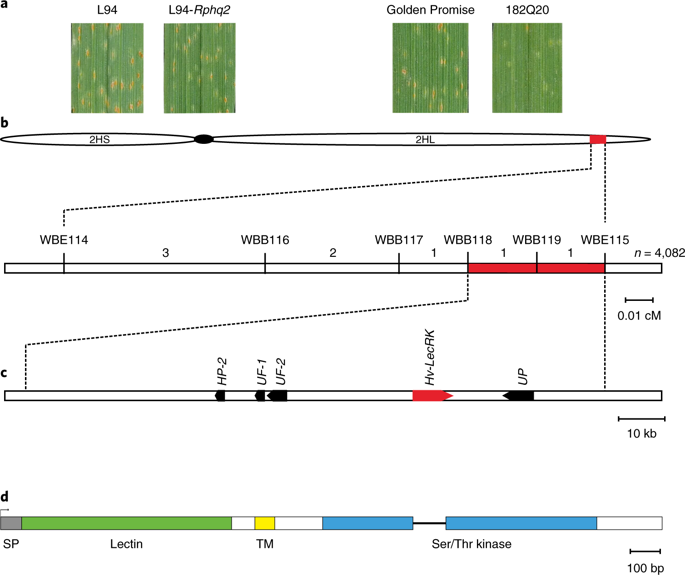当前位置:
X-MOL 学术
›
Nat. Plants
›
论文详情
Our official English website, www.x-mol.net, welcomes your
feedback! (Note: you will need to create a separate account there.)
Orthologous receptor kinases quantitatively affect the host status of barley to leaf rust fungi.
Nature Plants ( IF 15.8 ) Pub Date : 2019-11-11 , DOI: 10.1038/s41477-019-0545-2 Yajun Wang 1, 2 , Sudeep Subedi 1, 3 , Harmen de Vries 1 , Pieter Doornenbal 1 , Anton Vels 1 , Goetz Hensel 4 , Jochen Kumlehn 4 , Paul A Johnston 5 , Xiaoquan Qi 6 , Ikram Blilou 2 , Rients E Niks 1 , Simon G Krattinger 2
Nature Plants ( IF 15.8 ) Pub Date : 2019-11-11 , DOI: 10.1038/s41477-019-0545-2 Yajun Wang 1, 2 , Sudeep Subedi 1, 3 , Harmen de Vries 1 , Pieter Doornenbal 1 , Anton Vels 1 , Goetz Hensel 4 , Jochen Kumlehn 4 , Paul A Johnston 5 , Xiaoquan Qi 6 , Ikram Blilou 2 , Rients E Niks 1 , Simon G Krattinger 2
Affiliation

|
Global food security depends on cereal crops with durable disease resistance. Most cereals are colonized by rust fungi, which are pathogens of major significance for global agriculture1. Cereal rusts display a high degree of host specificity and one rust species or forma specialis generally colonizes only one cereal host2. Exploiting the non-host status and transferring non-host resistance genes between cereal crop species has been proposed as a strategy for durable rust resistance breeding. The molecular determinants that define the host status to rusts, however, are largely unknown. Here, we show that orthologous genes at the Rphq2 locus for quantitative leaf rust resistance from cultivated barley3 and Rph22 from wild bulbous barley4 affect the host status to leaf rusts. Both genes encode lectin receptor-like kinases. We transformed Rphq2 and Rph22 into an experimental barley line that has been bred for susceptibility to non-adapted leaf rusts, which allowed us to quantify resistance responses against various leaf rust species. Rphq2 conferred a much stronger resistance to the leaf rust of wild bulbous barley than to the leaf rust adapted to cultivated barley, while for Rph22 the reverse was observed. We hypothesize that adapted leaf rust species mitigate perception by cognate host receptors by lowering ligand recognition. Our results provide an example of orthologous genes that connect the quantitative host with non-host resistance to cereal rusts. Such genes provide a basis to exploit non-host resistance in molecular breeding.
中文翻译:

直系同源受体激酶定量影响大麦对叶锈菌的宿主状态。
全球粮食安全取决于具有持久抗病性的谷类作物。大多数谷物都被锈菌定殖,锈菌是对全球农业具有重要意义的病原体1。谷物锈病表现出高度的宿主特异性,一种锈病菌种或特殊形态通常只定殖于一种谷物宿主2。已提出利用非宿主状态和在谷类作物物种之间转移非宿主抗性基因作为持久抗锈病育种的策略。然而,定义锈病宿主状态的分子决定因素在很大程度上是未知的。在这里,我们展示了 Rphq2 基因座上用于定量抗叶锈病的栽培大麦 3 和来自野生球茎大麦的 Rph22 的直系同源基因影响叶锈病的宿主状态。两个基因都编码凝集素受体样激酶。我们将 Rphq2 和 Rph22 转化为实验性大麦品系,该品系已经培育出对非适应叶锈病的易感性,这使我们能够量化对各种叶锈病物种的抗性反应。与适应栽培大麦的叶锈病相比,Rphq2 对野生球茎大麦的叶锈病具有更强的抗性,而对于 Rph22,观察到相反的情况。我们假设适应的叶锈病物种通过降低配体识别来减轻同源宿主受体的感知。我们的结果提供了一个将定量宿主与非宿主对谷物锈病的抗性联系起来的直系同源基因的例子。这些基因为在分子育种中利用非宿主抗性提供了基础。这使我们能够量化对各种叶锈病物种的抗性反应。与适应栽培大麦的叶锈病相比,Rphq2 对野生球茎大麦的叶锈病具有更强的抗性,而对于 Rph22,观察到相反的情况。我们假设适应的叶锈病物种通过降低配体识别来减轻同源宿主受体的感知。我们的结果提供了一个将定量宿主与非宿主对谷物锈病的抗性联系起来的直系同源基因的例子。这些基因为在分子育种中利用非宿主抗性提供了基础。这使我们能够量化对各种叶锈病物种的抗性反应。与适应栽培大麦的叶锈病相比,Rphq2 对野生球茎大麦的叶锈病具有更强的抗性,而对于 Rph22,观察到相反的情况。我们假设适应的叶锈病物种通过降低配体识别来减轻同源宿主受体的感知。我们的结果提供了一个将定量宿主与非宿主对谷物锈病的抗性联系起来的直系同源基因的例子。这些基因为在分子育种中利用非宿主抗性提供了基础。我们假设适应的叶锈病物种通过降低配体识别来减轻同源宿主受体的感知。我们的结果提供了一个将定量宿主与非宿主对谷物锈病的抗性联系起来的直系同源基因的例子。这些基因为在分子育种中利用非宿主抗性提供了基础。我们假设适应的叶锈病物种通过降低配体识别来减轻同源宿主受体的感知。我们的结果提供了一个将定量宿主与非宿主对谷物锈病的抗性联系起来的直系同源基因的例子。这些基因为在分子育种中利用非宿主抗性提供了基础。
更新日期:2019-11-13
中文翻译:

直系同源受体激酶定量影响大麦对叶锈菌的宿主状态。
全球粮食安全取决于具有持久抗病性的谷类作物。大多数谷物都被锈菌定殖,锈菌是对全球农业具有重要意义的病原体1。谷物锈病表现出高度的宿主特异性,一种锈病菌种或特殊形态通常只定殖于一种谷物宿主2。已提出利用非宿主状态和在谷类作物物种之间转移非宿主抗性基因作为持久抗锈病育种的策略。然而,定义锈病宿主状态的分子决定因素在很大程度上是未知的。在这里,我们展示了 Rphq2 基因座上用于定量抗叶锈病的栽培大麦 3 和来自野生球茎大麦的 Rph22 的直系同源基因影响叶锈病的宿主状态。两个基因都编码凝集素受体样激酶。我们将 Rphq2 和 Rph22 转化为实验性大麦品系,该品系已经培育出对非适应叶锈病的易感性,这使我们能够量化对各种叶锈病物种的抗性反应。与适应栽培大麦的叶锈病相比,Rphq2 对野生球茎大麦的叶锈病具有更强的抗性,而对于 Rph22,观察到相反的情况。我们假设适应的叶锈病物种通过降低配体识别来减轻同源宿主受体的感知。我们的结果提供了一个将定量宿主与非宿主对谷物锈病的抗性联系起来的直系同源基因的例子。这些基因为在分子育种中利用非宿主抗性提供了基础。这使我们能够量化对各种叶锈病物种的抗性反应。与适应栽培大麦的叶锈病相比,Rphq2 对野生球茎大麦的叶锈病具有更强的抗性,而对于 Rph22,观察到相反的情况。我们假设适应的叶锈病物种通过降低配体识别来减轻同源宿主受体的感知。我们的结果提供了一个将定量宿主与非宿主对谷物锈病的抗性联系起来的直系同源基因的例子。这些基因为在分子育种中利用非宿主抗性提供了基础。这使我们能够量化对各种叶锈病物种的抗性反应。与适应栽培大麦的叶锈病相比,Rphq2 对野生球茎大麦的叶锈病具有更强的抗性,而对于 Rph22,观察到相反的情况。我们假设适应的叶锈病物种通过降低配体识别来减轻同源宿主受体的感知。我们的结果提供了一个将定量宿主与非宿主对谷物锈病的抗性联系起来的直系同源基因的例子。这些基因为在分子育种中利用非宿主抗性提供了基础。我们假设适应的叶锈病物种通过降低配体识别来减轻同源宿主受体的感知。我们的结果提供了一个将定量宿主与非宿主对谷物锈病的抗性联系起来的直系同源基因的例子。这些基因为在分子育种中利用非宿主抗性提供了基础。我们假设适应的叶锈病物种通过降低配体识别来减轻同源宿主受体的感知。我们的结果提供了一个将定量宿主与非宿主对谷物锈病的抗性联系起来的直系同源基因的例子。这些基因为在分子育种中利用非宿主抗性提供了基础。











































 京公网安备 11010802027423号
京公网安备 11010802027423号